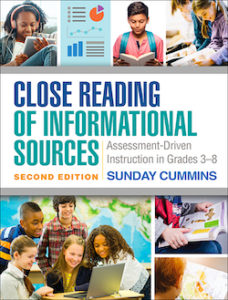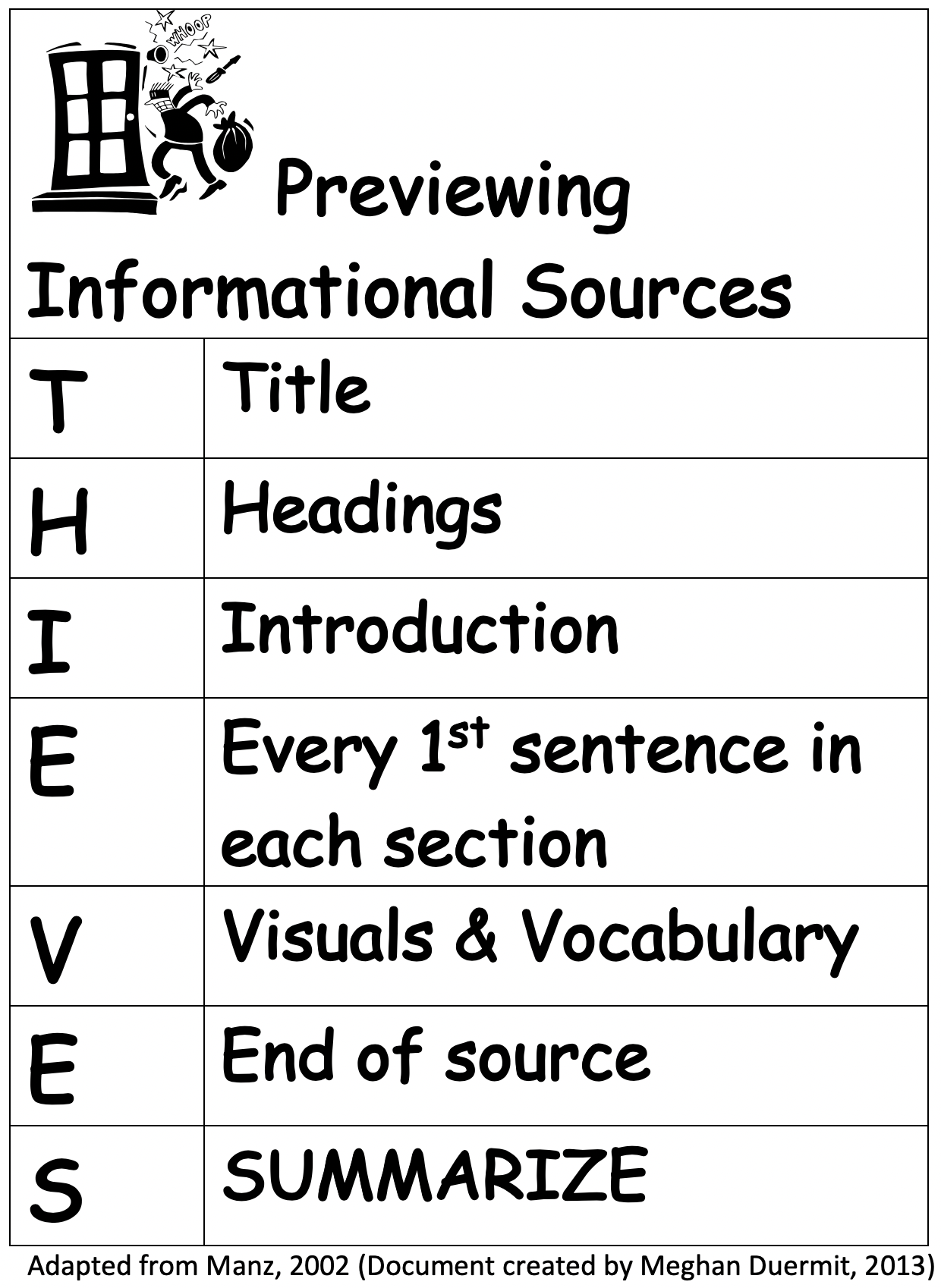Use THIEVES to Grab Nonfiction Readers
 By Sunday Cummins
By Sunday Cummins
Getting students excited about reading, viewing or listening to informational sources online may start off easy this fall. Want to read about your favorite sports star? YES! Want to watch a video on insect superfoods? YES! Want to learn about driverless cars delivering your pizza? YES!
But then what happens? For many of our students, engagement becomes superficial. They don’t read thoughtfully, thinking about what’s familiar, new or important – especially when they are on their own. This may be by choice or it may be because they need strategies to empower their reading experience.
What can we do to help? Start by explicitly teaching students how to make informed predictions before they read, watch or view a source. Then teach them how to use these detailed predictions to monitor for meaning making during and after reading, viewing or listening. The THIEVES mnemonic is a quick and easy tool that supports this endeavor.
Teach THIEVES for previewing and predicting, recalling and contrasting
Just like a thief may take something they feel need to get ahead in life, a reader can get ahead of an author by systematically previewing an informational source to make informed predictions.
As revealed in the sample bookmark below, each letter in the word THIEVES stands for a feature in the source (e.g., T—title, H—headings, I—introduction, E—every first sentence in each section, V—visuals and vocabulary, E—end of source) except the “s” which is a reminder to summarize what the reader has learned by previewing the features. ( Download)
Students do not have to look at every single feature listed to make a prediction (and many sources do not have all of these features anyway). When I present this mnemonic to students, I encourage them to pick a few relevant features and ask questions like the following:
• What might the topic of the source be based on what I notice in this feature?
• What do I already know about this topic?
• Based on the information in this feature and my background knowledge, what do I think I’ll be learning about in this source?
Then as they read, encourage students to compare what they are learning with what they predicted they would learn. You might post a purpose for reading like:
As you read, compare what you are learning with what you predicted you would learn. What are you surprised to learn? What are you not surprised to learn?
After reading, ask peer-led groups to engage in reflecting on how making informed predictions (using THIEVES) helped them interact with the content in the source, recall details, and even think critically about what they were learning. Examples of prompts include:
• What did you learn that resonated with your predictions?
• What did you learn that surprised you?
• What did you learn that contrasted with what you expected to learn about?
Using THIEVES in the virtual classroom
After an initial synchronous lesson introducing THIEVES, here are suggestions for supporting students’ use of THIEVES in online learning:
 ► In virtual meeting rooms, ask pairs or groups of students to collaboratively make predictions using the THIEVES mnemonic as a guide. Later – after reading, viewing or listening – ask them to return to the meeting room to discuss whether their predictions were on track.
► In virtual meeting rooms, ask pairs or groups of students to collaboratively make predictions using the THIEVES mnemonic as a guide. Later – after reading, viewing or listening – ask them to return to the meeting room to discuss whether their predictions were on track.
► Ask students to design a digital bookmark with the THIEVES mnemonic that can be posted on their desktop as a visual reminder.
► Assign students to make and post a quick Flipgrid video sharing their predictions before reading and then a follow-up video comparing their predictions to what they learned.
► Facilitate a debate about what students will be learning from a source. Screen share one strong feature from a source (like a map or diagram or a complicated title) for all students to view and pose a question like, “What do you think you’ll be learning about from a source that includes this feature?” Push students to draw support from the feature and their background knowledge, generating numerous predictions. Then return to these predictions for additional conversation after revealing and engaging with the source as a whole.
THIEVES transfers to a wide variety of on-line sources
Don’t worry about thinking through how to use THIEVES with a video or an infographic or any other type of source. Instead, put your students to work. After you have introduced THIEVES with a traditional source like a news article, simply ask students how they might use THIEVES with this different type of source.
If they understand the power of making informed predictions before reading, they will probably be enthused about planning for how to do this before watching a video or listening to an audio clip. Provide time for small groups to meet and come up with a way to apply THIEVES to this new type of source. Then encourage them to give it a go.
You can also check out tips I share for making predictions before viewing a video and when previewing an infographic in previous MiddleWeb articles I’ve written.
NOTE: See more of Sunday’s recent thoughts about virtual teaching at her blog.
 Sunday Cummins is a literacy consultant and author and has been a teacher and literacy coach in public schools. Her work focuses on supporting teachers, schools and districts as they plan and implement assessment driven instruction with complex informational sources including traditional texts, video and infographics. She’s the author of several professional books, including her latest releases, Close Reading of Informational Sources (Guilford, 2019), and Nurturing Informed Thinking (Heinemann, 2018).
Sunday Cummins is a literacy consultant and author and has been a teacher and literacy coach in public schools. Her work focuses on supporting teachers, schools and districts as they plan and implement assessment driven instruction with complex informational sources including traditional texts, video and infographics. She’s the author of several professional books, including her latest releases, Close Reading of Informational Sources (Guilford, 2019), and Nurturing Informed Thinking (Heinemann, 2018).
Sunday is a graduate of Teachers College, Columbia University, and has a doctorate in Curriculum and Instruction from the University of Illinois, Champaign Urbana. Visit her website and read her regular blog posts on teaching information literacy. Follow her on Twitter @SundayCummins.


































